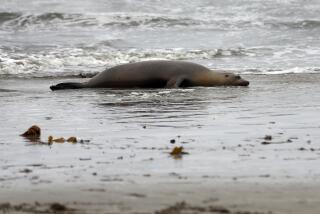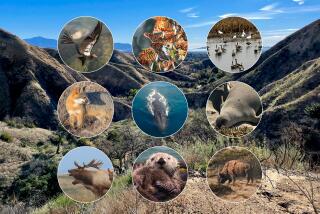BEACHED BEDLAM : Once Near Extinction, Elephant Seals Crowd San Miguel Island for Annual Mating Frenzy
Four thousand northern elephant seals--huge mounds of fur and blubber that resemble cute little circus seals the way King Kong resembles Bonzo--are packed belly to belly on a beach on San Miguel Island, the most remote island in the Channel Islands National Park.
Mouths agape, they are fighting, birthing, resting, whining, roaring, shoving and mating like crazy. The older males square off--as much as their 3,800 pounds and 13 feet will allow--and spar for territory, ripping and bloodying the thick skin around their great necks. Through their trunk-like snouts, they let loose noises like a pile driver pounding a metal shed. Whenever a female bears a calf, screeching sea gulls swoop in for the afterbirth.
Mothers bellow when their calves stray too far. The battles for mothers’ milk and for mates--a bull will mate with as many as 20 females a season--are ceaseless. In a sign of irritation partly due to the presence of human intruders, thousands of flippers throw up spumes of sand all over the beach, bringing the panorama to a boil.
The scene is the business of life for Mirounga angustirostris , and even National Park Service veterans gaze upon it with awe.
‘All That Biomass’
“It’s truly startling to see all that biomass out there,” said Don Morris, the park’s acting resource manager. “Before I saw it for the first time four years ago, I’d never seen that much wildlife in one place. I don’t think many people have.”
One marvel is that it happens at all.
Around the turn of the century, elephant seals were thought to be near extinction. After 50 years of slaughter for the use of their oil in lamps, the species had dwindled to as few as 100 known animals that would breed and pup on Guadalupe Island, 150 miles west of Baja California. Hunted by the Chumash Indians, U.S. and Russian traders, and Chinese merchants who extracted purported aphrodisiacs from the seals’ testicles, the species had disappeared from San Miguel.
They began a slow return in the 1940s and have been multiplying furiously ever since. Half the world’s northern elephant seals are born on the island from December through February.
Today, scientists estimate, the northern elephant seal population has soared to 120,000. And San Miguel, also a port of call for tens of thousands of harbor seals, California sea lions and three rarer species, hosts “the biggest concentration of seals in the Northern Hemisphere south of Alaska,” said biologist Brent S. Stewart, a veteran seal observer on the 14-square-mile island.
San Miguel also has one of the smallest concentrations of people. A park ranger and his family live at one end. At the other end, a few scientists sporadically put in time at a “research station,” a one-room stucco shack commanding a view of pristine coves and dunes covered with ice plant.
An island fox jumps here; a meadowlark warbles there. Wind rakes the island, sometimes exposing the bones at Chumash burial sites. Meanwhile, the elephant seals, whose ranks are swelling by about 8% a year, take over new stretches of beach.
“So many big mammals around the world are in serious trouble,” said Stewart, a staff scientist with Hubbs Marine Research Center in San Diego, “but this is one of the very few that actually has been growing over the last century.”
12 Years of Research
For 12 years, Stewart, a hearty, red-bearded man who peppers his enthusiastic seal monologues with such phrases as “median weaning date,” has tried to figure out why, and at what point, the elephant seal population will expand beyond its natural limits.
To be sure, the lamp-oil trade died about 1870, the furs of elephant seals never were terribly attractive, and the National Marine Mammals Act of 1972 forbade killing them or any other seal. But, while several other seal species have dwindled or come back only modestly, elephant seals, along with California sea lions, have rebounded with gusto.
In 1977, the Air Force contracted with Hubbs, a division of the Sea World Research Institute, for what was to become a long-term seal study. Among other things, officials wanted to predict the effects of space shuttle launches from Vandenberg Air Force Base, fearing that sonic booms might stampede the breeding animals.
Each year since, Stewart has studied the flip side of extinction.
“There really isn’t a good understanding of what influences large-mammal populations,” he said, stepping nimbly across the beach to avoid angry nips. “We need to find out where they’re feeding and whether males and females feed in the same places. We want to find out if animals from different colonies use the same area. We don’t even know exactly where they go when they’re not here.”
Small details fill the life of a seal researcher. The bigger patterns will emerge only over elephant-seal generations of perhaps 20 to 30 years--nobody knows just how long the animals live. So far, many of the discoveries of Stewart and others are more intimate than monumental.
Days Females Arrive
Stewart, for instance, can tell you the exact days, Jan. 12 to 15, that female elephant seals are most likely to arrive at San Miguel, where males have been waiting for a month. An average of seven days later, their pups emerge, the products of 11-month pregnancies.
The fatigued mothers get little rest. Nursing takes 26 to 28 days. Mating begins almost immediately, and, although the act lasts only about 15 minutes, its repetition trims 1,600 pounds, almost half their body weight, off the big males before they waddle back into the sea.
Stewart has mapped the space each colony claims, watching approvingly as greater expanses of beach are filled with seals. Year after year, he tallies the stillborn. He measures the pups, noting less growth in pups of females continually harassed by demanding mates.
He has delved into the digestive systems of dead elephant seals to see what remains of their food, mainly squid and other deep-water creatures. He has measured the rings inside their teeth in an attempt, so far futile, to guess their ages.
He has trekked to Greenland, Antarctica, Alaska and the Soviet Union in search of seal data, and he has escorted Soviet scientists to San Miguel.
With sophisticated pressure gauges, Stewart and Robert De Long, a National Marine Fisheries Service research biologist, discovered that elephant seals can dive an astounding 5,000 feet and spend as long as 80 minutes submerged.
Satellite Monitoring
De Long is even arranging for satellite monitoring to learn just where elephant seals spend their months at sea, although, he acknowledged, they bob to the surface so infrequently that satellites might not be able to discern them very often.
But for all the investigation, the elephant seals’ spectacular comeback is still something of a mystery.
“It’s very hard to know,” said Charles D. Woodhouse, an oceanographer who directs marine mammal research for the Santa Barbara Museum of Natural History. “Both the elephant seal and the Guadalupe fur seal were nearly (killed off), but today there are only about 2,000 Guadalupe fur seals.
“Maybe elephant seals forage in a different way. Maybe they dive deeper and feed in a different habitat. Maybe their breeding success is much higher. There’s a kind of population yo-yoing going on here that we just don’t have the answers to.”
Just where it will stop, nobody knows.
Elephant seals have few natural enemies. Sharks attack them from time to time, Stewart said, but do not seem to have significantly limited the population.
Humans haven’t limited them much lately, either. Unlike California sea lions, elephant seals pose no threat to fishermen because they dive deeper than levels at which fishermen cast their nets.
And tourists are scarce. Island Packers, the Ventura-based visitor ferry to the Channel Islands, chugs out to San Miguel only about a dozen times a year and then only during the warmer months when the elephant seals, if not some of the other species, have taken off for parts unknown.
But, pinched by lack of food or lack of room or too many enemies, all populations peak--and when that happens on San Miguel, Stewart said, he wants to be there to chronicle it.
Until then, his days of tagging and measuring, of taking notes and squinting into the wind can be trying.
“There’s so much chaos here,” he said, gesturing toward the bedlam of seals. “It really has an influence on your nervous system. Sometimes they threaten you. The males may charge. Sometimes I feel pretty worn out.”
More to Read
Sign up for Essential California
The most important California stories and recommendations in your inbox every morning.
You may occasionally receive promotional content from the Los Angeles Times.










